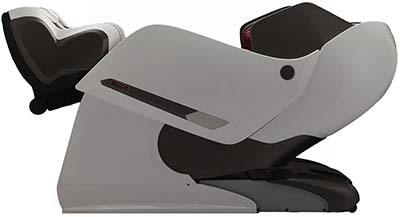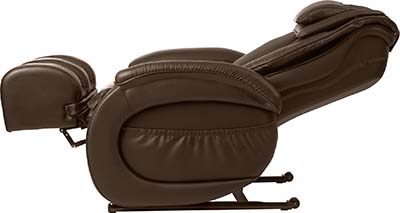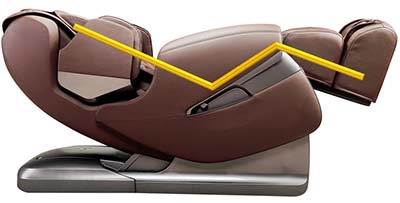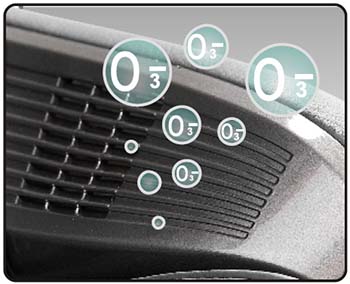The term “massage chair” encapsulates an overwhelming variety of products from recliners that vibrate to medical devices that diagnose tension and prescribe treatment.
So how do you know which type of massage chair is best for you?
In this article, we’re walking you through the different types of massage chairs, breaking them down by massage type, track type, roller type and more. By the end, you’ll have an understanding of the fundamental components of massage chairs and a better awareness of the type of chair that will work for you.
Let’s get started!
Types of Massage Chair: Massage Styles
On a massage chair, there are three main massage components: rollers, airbags, and vibration. There are chairs with one of these components, two, or all three of them.
Roller Massage
Rollers are perhaps the most quintessential massage chair component. They serve as the “hands” of the massage chair and are what perform techniques like kneading and shiatsu. As they massage, the rollers manipulate the muscle tissues. It’s this muscular manipulation that is the foundation of massage therapy and the therapeutic benefits derived from it.
Air Massage
Another common massage type is air massage which is performed by airbags that inflate and deflate to squeeze the body. Air massage is typically found on full body massage chairs as they are used to treat the areas rollers can’t reach like the outer shoulders and hands. Airbags are also used to perform advanced massage techniques such as twists, swings, and stretches.
To learn more about air massage, check out our review of the Inada DreamWave which has some of the most advanced air massage technology available.
Vibration Massage
Lastly, there’s vibration massage which uses high-frequency vibration plates to stimulate an area and increase local circulation. Typically, massage chairs that only offer vibration massage are recreational and aren’t intended to be replacements for massage therapy.
To learn more about a vibration massage chair, check out our review of the T&D Massaging Black Leather Recliner.
Types of Massage Chair: Roller Tracks
But to get any real muscular benefits from a massage chair, you need one that has rollers. Of the massage chairs that have rollers, there are three different types of tracks, or the mechanism which the rollers move along as they massage. Track type plays a key role in massage feel as well as the range of the rollers.
Straight Track
A straight massage track is linear from top to bottom. Since they’re straight, a common issue with straight tracks is that they lose contact and pressure in curved areas like the neck and lower back, which is why they’re typically only found on highly affordable or recreational massage chairs.
To learn more about a massage chair with a straight track, check out our review of the Human Touch Active 2.0.
S-Track
S-Tracks are the answer to that issue. S-Tracks are shaped like an “S” to replicate the natural curvature of the spine to ensure the rollers work with the body and keep consistent contact. S-Tracks typically extend from the neck to the tailbone depending on their length, which is usually between 24 to 32 inches. S-Tracks are the most common track type and are found on any quality massage chair.
To learn more about a massage chair with an S-Track, check out our review of the Osaki OS-4000.
L-Track
L-tracks are extended tracks that pick up where S-Tracks end at the tailbone and continue into the seat of the chair. L-Tracks extend the range of the rollers by 15 inches or more, allowing them to treat the glutes, piriformis, and hamstrings.
Since their introduction, L-Tracks have continuously grown in popularity for their additional coverage as well as the benefits they offer those with sciatic nerve pain.
To learn more about a massage chair with an L-Track, check out our review of the Infinity Iyashi.
Different Types of Massage Chairs: Roller Heads
The rollers themselves also come in different varieties. There are three types of rollers: 2D, 3D, and 4D.
2D Rollers
When referring to roller type, the number in 2D represents the number of dimensional movements and the “D” represents dimensions. So we know 2D rollers move in two ways: horizontally and vertically.
3D Rollers
3D rollers move in three ways and include the additional dimension of depth. Depth refers to the ability of the rollers to extend from the track to penetrate deeper into your muscle tissues. Another way of looking at it is that 3D rollers let you control the intensity of your massage. So 3D rollers are recommended for deep tissue and gentle massage enthusiasts alike since they let you customize the pressure.
To learn more about a massage chair with 3D rollers, check out our review of the Panasonic EP-MA73.
4D Rollers
4D rollers include all of the dimensional movements of 3D, plus a fourth called rhythm. With 4D, the rollers vary their speed (rhythm) to replicate the dynamic speeds a massage therapist might use. So rather than moving at the same speed throughout your massage, the rollers sometimes speed up or slow down to provide a more lifelike feeling.
To learn more about a massage chair with 4D rollers, check out our review of the Apex Regent.
Different Types of Massage Chairs: Additional Features
We’ve covered the fundamental components of different types of massage chairs. But there are additional features you’ll want to consider when differentiating between chair types. These features aren’t necessarily determined by chair price, so you’ll find both entry-level and high-end massage chairs with them.
Body Scan Technology
Body scan is a technology that uses sensors to “map” your back. At the most basic level, it detects the position of your shoulders so that the rollers don’t hit too high or too low relative to them. At the most advanced level, it detects your height, shape, and shiatsu points before automatically adjusting the rollers to perform a custom-fit massage.
As the chair price goes up, so does the sophistication of the body scan technology. However, many affordable models feature at least shoulder height detection.
Unless you specifically want to manually adjust the position of the rollers each time you use the chair, body scan technology is recommended to ensure proper roller position.
Tractioning or Inversion Therapy
You won’t find traction or inversion therapy on any highly-affordable models. But if you have the budget, there are a few massage chairs out there that offer these advanced therapies.
The Infinity IT-9800, for example, offers slight inversion during which the chair reclines past 180 degrees to gently pull and stretch the spine.
And the Inada DreamWave features a patented neck tractioning device that pushes the shoulders away from the head to stretch the spine, create space between the vertebrae, and relieve pinched nerves.
Zero Gravity
The term Zero Gravity is almost synonymous with massage chairs. This is because due to popular demand massage chair companies have quickly been adding it to their models.
So what’s the big deal?
Zero Gravity is considered to be one of the most therapeutic chair positions possible. In fact, it was originally developed by NASA to help astronauts cope with the gravitational stress of taking off in a rocket.
In Zero Gravity, the chair reclines such that most of the body’s weight is shifted to and held by the backrest. At the same time, the legs are elevated at or above the heart. With vertical pressure removed and the weight of the body offset, the spine and muscles are able to decompress and relax.
Zero Gravity is particularly well-suited for massage chairs because it uses the user’s own weight to hold him on top of the rollers for a deeper massage, while also increasing the circulation in the legs and feet.
Massage-Enhancing Features
Music systems are found on many massage chairs and typically consist of an MP3 port or Bluetooth connectivity and built-in speakers. Once you connect your compatible device, the chair plays your music, giving you a surround sound experience during your massage. Although music doesn’t directly affect your massage, it can enhance the experience.
Other popular massage-enhancing features include heat therapy, chromotherapy lights that cast hues onto the walls in a dark room, and negative ion generators.
To learn more about a massage chair with a negative ion generator, check out our review of the Apex Lotus.
Choosing the Right Massage Chair
Choosing the right massage chair can be a daunting task, especially if you are unsure of the different types that are out here. To help you zero in on the type of massage chair that will suit you best, we’ve compiled a few questions to ask yourself.
Different Types of Massage Chairs Final Thoughts
Getting a grasp on the different types of massage chairs comes down to understanding the main components. Once you’ve decided on the massage style, track type, roller type, amount of coverage, price, and additional features you’d like your massage chair to have, all that’s left to do is find the one that offers that specific combination!





